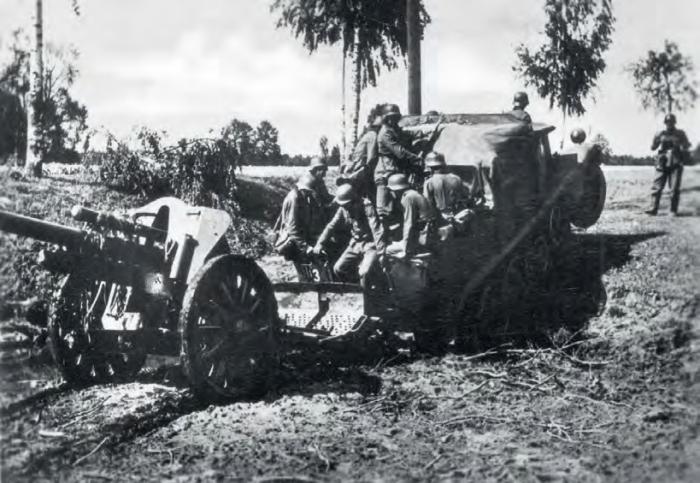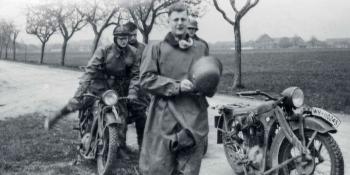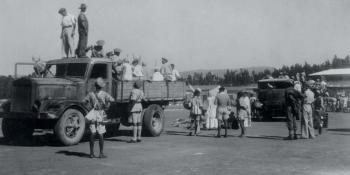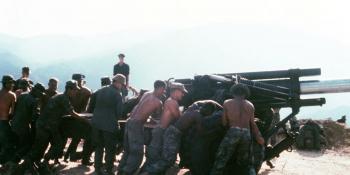In the years after World War One thoughts turned to developing a new gun for the German Army

In the 1920s, as the German Army (Reichsheer) planned to re-equip, thoughts turned to putting into service a new standard light field gun. The officers charged with developing the gun had recent war experience to draw upon. During the war, Germany had fielded guns with a bore of 7.7cm and howitzers with a bore of 10.5cm. In the future, it would ease ammunition manufacture and supply if there was only one standard light field gun.
A bore of 10.5cm was chosen as, although the shell would be bigger than that fired by a 7.7cm gun, the gun itself would be not very much larger and would therefore still be reasonably easy to handle in the field. (In due course, wartime 7.7cm guns would be re-barrelled to fire a 7.5cm shell, and a new 7.5cm gun would be designed and put into service in limited numbers from1938 - so much for the idea of standardising on 10.5cm.
Having decided on a bore of 10.5cm, the next decision was whether the new gun should indeed be a gun, or a howitzer. A gun has a relatively long barrel, allowing time for the propelling charge to impart energy to the shell and thus attain a high muzzle velocity and long range. Trajectory of a gun’s shell is low; with an allowance for the effects of gravity at longer ranges, the gun is aimed directly at the target.
This is ideal when engaging advancing soldiers and German field guns were the only effective weapons when the British first attacked with tanks. A gun was less suitable for attacking fieldworks or entrenched troops however, as shells either burst on the breastwork or passed harmlessly overhead. In contrast, a howitzer has a relatively short barrel and was fired at a high elevation.
For an equivalent propelling charge as used in a gun, the shell did not travel as far but due to the high elevation of the barrel it fell out of the sky and into fieldworks or trenches.
Guns and howitzers designed in the early years of the 20th Century began to take on each other’s characteristics, and it was decided that the new gun for the Reichsheer would continue that process and be a gun-howitzer.
Rheinische Metallwaren-und Maschinenfabrik was awarded a development contract in 1928, and the new gun-howitzer was mass produced from 1935. It was designated the 10,5cm leichte Feldhaubitze 18 (10,5cm leFH 18, 10.5cm Light Field Howitzer).
The barrel was long compared with that of the 10.5cm howitzer used during the recent war; at 2.941m (9ft 8in) it was 28 calibres long, whereas the wartime howitzer had a barrel only 22 calibres long. The total elevation arc was 47 degrees 37 minutes, allowing both direct and high-angled fire. The barrel and recoil assembly was mounted in a cradle which was in turn mounted on a split-trail gun carriage running on two wheels. Ideally, the new gun would be towed by a new gun tractor.
Such a tractor was in the course of development, but, given the size of the army that was being planned, there would never be enough tractors for all the guns. Most would therefore be horse-drawn.
To make the guns as easy as possible for horses to tow across rough ground, traditional large-diameter wheels were fitted to the gun carriage. Initially, these were pressed alloy with steel tyres, but traditional wooden-spoked wheels would be fitted from around 1942 in order to conserve metal stocks.
To prevent a gun over-running the horses on a gradient, brakes were fitted; these were operated via traces by a gunner riding on the limber. Guns that were to be towed by a motor vehicle were fitted with solid rubber tyres, and dampers were fitted to the leaf-spring suspension to allow towing at higher road speeds. The brakes were operated by a gunner riding in the gun tractor.
The two trails of the gun carriage were brought together for towing, and spread apart for firing (though for anti-tank fire the trails did not need to be spread). When the trails were spread, a cam mechanism locked out the leafspring suspension thus forming a stable gun platform.
When the trails were spread, it was a not easy to traverse the gun carriage – especially if the soft ground spades at the ends of the trails had been deployed, and had dug into the soil when the gun was fired.
So the gun cradle allowed a wide traverse upon the carriage: total traversing arc was 56 degrees 14 minutes, equal both ways, to right and to left. The traversing wheel was on the left-hand side of the cradle, as was the gun sight. The elevating wheel was on the right-hand side. Traverse and elevation were therefore the responsibilities of two separate gunners.
Horse-drawn leFH 18 Batteries
As noted above, most of the guns would be horse-drawn. A team of six horses was the standard allocation, but in very bad conditions, as would be found in the Soviet Union, up to ten would be required. When horse-drawn, the gun was used with a two-wheeled limber which carried ammunition and members of the gun crew.
Motorised leFH 18 Batteries
Of more interest to us here are the gun tractors that were issued to artillery regiments allocated to the Panzer and motorised divisions.
In 1934, the Reichsheer commissioned Krauss-Maffei to design and build a prototype light cross-country prime mover; the company was already working on a medium cross-country prime mover. Having built a single semitrack prototype, development and series production was passed to Büssing-NAG which built eight more prototypes then revised the design for series production starting in 1935. In due course, Daimler Benz and Praga would also build the vehicle.
The production vehicle was based on a pressed steel frame. Its Maybach six-cylinder petrol engine was located at the front, its weight supported by two wheels fitted with pneumatic tyres. The wheels were sprung, but not driven; they were used to steer the vehicle when only small turns were required. The engine drove a four-speed gearbox, two-speed transfer box and a controlled differential steering unit mounted below the driver’s seat. The steering unit was operated by the driver’s turning of the steering wheel. A small turn of the wheel moved the front wheels only; continuing to turn the steering wheel brought the steering unit into play, and it slowed the right track and speeded the left (or vice versa, as appropriate to the turn). The rubber-shod manganese-steel tracks were very sophisticated. The links were joined by steel pins, and these ran in needle bearings each with its own grease nipple. The drive sprocket was raised off the ground, as was the return idler at the rear of the semi-track assembly – the latter only just. In between them, the tracks ran on four sets of interleaved rubber-tyred road wheels. The road wheels were sprung by leaf springs. An engine-driven winch was fitted towards the rear of the frame.

The bodywork of the gun tractor had three rows of seats (including that occupied by the driver) and stowage compartments at the rear.
Military designation was Sonderkraftfahrzeug 6/1 (Sd Kfz 6/1, Special Motor Vehicle 6/1).
Early in 1937, it was re-classified from a light prime mover to a medium prime mover. In November 1937, the semi-track assembly was lengthened by the addition of two more sets of interleaved road wheels and somewhat later the leaf springs were replaced by torsion bars.
In the years that followed, until production ceased in 1943, further detailed design changes took place, but the essential characteristics of the vehicle did not alter.
Sd Kfz 6/1 was an excellent gun tractor, though expensive to build both in raw materials and in workers’ time. With a towing capacity of five tonnes, it was also over-specified for the leFH 18. So although it was issued to some batteries equipped with that gun, the preferred tractor was the three tonne Sd Kfz 11.
In 1933, design work began at Hansa Lloyd on a small cross-country tracked tractor; this would be developed to become the Sd Kfz 11 leichter Zugkraftwagen 3t (Light Prime Mover threetonne).
The automotive layout of this vehicle was the same as the five-tonne Sd Kfz 6, though it was powered by a Hansa Lloyd petrol engine and the semi-track assembly ran on seven sets of interleaved rubber-tyred road wheels (the last of which served also as the track return)…


Suspension was by torsion bars from the start of production. Cost and complication was reduced by not fitting a winch. For use as an artillery tractor, a purpose-designed body was built with the stowage compartments located in the centre of the vehicle rather than at the rear.
They were built to the full height of the vehicle, the roof being extended forward to enclose the driver’s cab. Behind the stowage compartments was an open crew compartment (though it could be enclosed by a canvas tilt).
Crew access was via an open entrance at the rear of the vehicle. Inside were longitudinal bench seats each side. However, troop trials led to the design of the body being modified. The stowage compartments were reduced to waist height and the roof over the driver’s cab was removed. This became the standard artillery body, designated normal Artillerieaufbau (Normal Artillery Superstructure).


As production continued, the vehicle underwent changes: various Maybach engines were fitted from 1937, and in 1938 responsibility for developing the design passed to Hanomag.
Production, by a number of different companies, of the normal Artillerieaufbau gun tractor ceased in 1944 after about 4,500 examples had been built, though batteries were issued with an Sd Kfz 11 having simplified wooden bodywork which continued in production until early 1945.
Guns were also hauled by Sd Kfz 11 fitted with bodies comprising four rows of seats and a tool storage compartment at the rear; only 146 examples of this body were built in 1938-1939.
Some batteries in Panzer divisions were issued with the armoured vehicle based on the Sd Kfz 11 chassis: the Sd Kfz 251. This was normally used as an armoured personnel carrier, but the artillery units to which it was issued used it as a gun tractor.


KStN 434, Batterie leichte Feldhaubitze (motorisiert) (Light Field Howitzer Battery, motorised) was issued on October 1, 1938. It specified the allocation of men and equipment to such as an leFH 18 battery. A battery comprised four guns, each with its own semi-tracked gun tractor; each gun was served by a commander and seven gunners. The guns were allocated to the battery’s gun section, which in additionto the gun tractors, had two solo motorcycles and four Kübelwagen. One of the motorcycles was for an NCO medic and the other for a dispatch rider. One of the Kübelwagen was a light cross-country field car; cars serving in this role were designated Kraftfahrzeug 1 (Kfz 1).
The car was probably for use by the officer commanding the section. Two other Kübelwagen were Kfz 12, a medium cross-country field car fitted with a tow hook. These were probably for use by motor mechanics and the battery’s computation party, which calculated bearings to intended targets. The fourth Kübelwagen was a Kfz 4, which was fitted with an anti-aircraft mount for twin machine guns. There were two ammunition sections with a total of eight light cross-country lorries, open (leichter geländegängiger Lastkraftwagen, offen). This was a very specific designation, and in 1938 only one vehicle met it: the Einheits-Lastkraftwagen (Standard Lorry). The six-cylinder diesel engine of this lorry drove its six wheels via a four-speed gearbox and two-speed transfer box. Each wheel had independent coil-spring suspension, and each of the three differentials was self-locking.
However, payload was only 2.5 tonnes, and the lorry could not cope with overloading. Production ceased in 1940 in favour of simpler types such as the 4x4 version of the threetonne Opel Blitz, introduced in July 1940.
Batteries attached to Panzer divisions and light motorised brigades also had four multi-wheel trailers to carry ammunition. Three solo and one combination motorcycle, were provided for the officer in command and senior NCOs.
Two service sections had a total of four lorries to carry such as baggage, food, fuel and a field cooker, one solo and one combination motorcycle and a five-tonne semi-track prime mover.
The specific purpose of this prime mover is not given, but presumably it was used to recover broken down or stuck vehicles and guns, and could serve as a gun tractor if required.
The battery was led by a command section, which had two Kübelwagen – one each for the battery commander and the observation officer.
These were both medium cross-country field cars, one with and one without a tow hook (Kfz 11 and Kfz 12). Three dispatch riders were each issued a solo motorcycle.
Working closely with the battery commander was the communications section. This was issued with five Kübelwagen: two light radio cars (Funkkraftwagen Kfz 2); one light signals car (Nachrichtenkraftwagen Kfz 2); one medium signals car (Nachrichtenkraftwagen Kfz 15); one heavy field telephone car (Fernsprechkraftwagen Kfz 23). There was also a 6x4 observation lorry (Beobachtungskraftwagen Kfz 76), carrying a tripod ladder to give the observation officer an elevated view when required, plus telescope, rangefinder etc.
Ammunition
The 10,5 cm leFH 18 fired four types of shell. Manufactured in the largest quantities were high explosive shells. Smoke shells were used to cover attacks and withdrawals, and to mark targets for aerial attack. Armour-piercing shells were filled with high explosive, and had a fuse in the base so that they would not function until after penetration of the target. Armour-piercing shells were also fitted with a tracer element, so that the gunner could see where they went and could correct his aim if required. During the war years, hollow-charge armour-piercing shells would be introduced. Hollow-charges focused the power of the explosion, and could penetrate up to 7.5cm of armour plate. Gas shells were manufactured in large quantities, but were never used.
The propellant was loaded separately from the shell – it was contained in a stubby brass or steel cartridge case. This was to make it easy to vary the size of the propelling charge and thus the distance fired. The normal charge as supplied from the manufacturer was designated Zone 5.

Most shells, including armour piercing, were fired with this charge. However, if greater range was required, a Zone 6 charge was used. To prepare, the loader removed the lid from inside the cartridge case, and then removed all five bags of propellant. These were replaced by a Zone 6 charge.
The lid was then put back, and the cartridge case loaded into the breech of the gun. Zone 6 charges were only used as strictly necessary, as the more powerful charge increased wear of the barrel and tear of the gun carriage. For reduced range firing, one or more of the five standard bags were removed before loading into the breech. For night firing, a spun lead wire flash-reducer could be added to the charge in the cartridge case, though its use reduced the range of the shell. Maximum range with a Zone 6 charge was approximately 10,700m (11,700 yards), reducing to 9200 m (10,000 yards) with the standard Zone 5 charge.

Consumption of Steel
It is useful here to contemplate the huge quantity of steel used in the production of ammunition.
In the 1930s, Germany had to import most of its iron ore from Sweden; although Germany did have its own deposits, their chemical characteristics were such that they could not be used for steel-making using the methods employed by German companies.
In the 1930s, German industry was not competitive on world markets, so earned relatively little in foreign exchange. This in turn made it difficult for the German state to finance the purchase of Swedish iron ore. Nevertheless, by September 1940 the Heer had a stockpile of 21.9 million 10.5 cm leFH 18 shells, the production of which had absorbed in excess of 250,000 tonnes of steel. (There were over 5000 leFH 18 in service at this time.) Such a stockpile of ammunition was of course necessary if Germany was to wage war on the Soviet Union, but allocations of steel for munitions production inevitably impacted upon allocations for the manufacture of such as tanks, guns and trucks.
War Service
The 10,5 cm leFH 18 was an excellent gun, and as well as being adopted by the Heer (as the Reichsheer had become in 1935) it was sold to foreign armies. One of those was that of the Spanish Nationalists, and the gun first saw active service in the Spanish Civil War. From September 1, 1939, the Heer was engaged in its own war. The leFH 18 proved its worth. However, it was outranged by the British 25 pounder and the Soviet 76.2 mm M1939 (though these guns fired a smaller shell.)



Longer range for the leFH 18 was deemed therefore useful, and in 1941 a revised gun entered service, the 10,5 cm leFH 18M. This was fitted with a muzzle brake and a revised recoil system to allow the use of a newly-designed long-range shell and its powerful propelling charge. Many existing guns were re-built to the new design.
Both the leFH 18 and the leFH 18M were rather heavy – they weighed very nearly two tonnes. This weight proved troublesome in the muddy conditions experienced in the Soviet Union, and guns were lost when they could not be extracted from firing positions before they were overrun by the Red Army. (The 25 pounder weighed about 1.6 tonnes.) In 1942 therefore, production of the leFH 18M was augmented by that of the leFH 18/40; this gun was an leFH 18M on the carriage of a 7,5cm Pak 40 (7.5cm Anti-Tank Gun 40) running on larger wheels.
Weight was in fact not much reduced, but the carriage was easier to manufacture.


Communications
The range of an leFH 18 being further than it was normally possible to see, forward observation was very important. Each battery was responsible for its own observations, and it was not uncommon for a battery commander to accompany the infantry leading an attack, especially if he was unfamiliar with the terrain.
Communication back to the battery, using pre-arranged codes, was initially by radio. Man-portable radios were each operated by two men; one carried the transceiver and the other the accessories, battery and antenna. Once set up, a radio had a range of about five miles. Prone to waterlogging, the radios had to be kept dry. As soon as possible, the battery’s signalers would install telephone lines between the forward observers and the battery.

Further Reading
Tactical and Technical Trends, No 6, 27 August
1942 : Notes on German Divisional Artillery. Tactical and Technical Trends, No 7, 10 September
1942 : Organization and Identification of German Artillery Units.
Tactical and Technical Trends, No 26, 3 June 1943 : German Radio Communications for 105-mm Gun Battery.
TM E9-325A : German 105-mm Howitzer Material, 15 June 1944.




